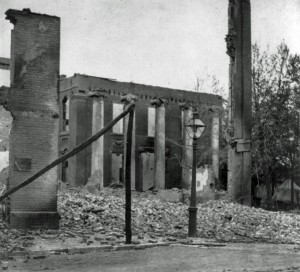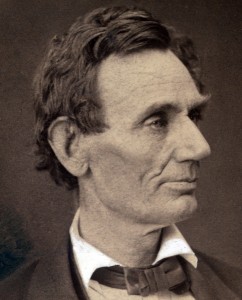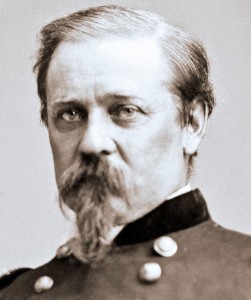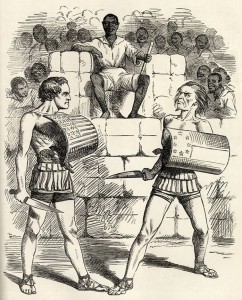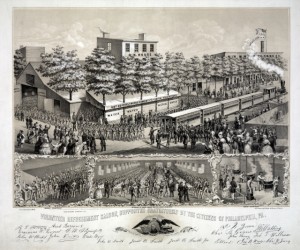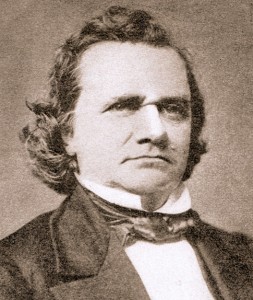 In late October 1860 the (Montpelier) Vermont Patriot confidently predicted that Senator Stephen Douglas would win Illinois’ electoral votes. “Illinois has never yet voted against the Democratic party for President,” as the Vermont Patriot noted. Democratic papers like the Vermont Patriot argued that voters had to support Douglas in order to remain “high above the surges of fanaticism.” This election, as the Springfield (IL) State Register explained, would result in either “harmony between the States or discord and civil war.” Yet on election day in 1860 Illinois went for the Republican ticket, Abraham Lincoln and Hannibal Hamlin. The Vermont Patriot would later describe the 1860 contest as “a Presidential election without a parallel.” You can learn more about Stephen Douglas and the 1860 election in Robert Walter Johannsen’s Stephen A. Douglas (1973) and James L. Huston’s Stephen A. Douglas and the Dilemmas of Democratic Equality (2007).
In late October 1860 the (Montpelier) Vermont Patriot confidently predicted that Senator Stephen Douglas would win Illinois’ electoral votes. “Illinois has never yet voted against the Democratic party for President,” as the Vermont Patriot noted. Democratic papers like the Vermont Patriot argued that voters had to support Douglas in order to remain “high above the surges of fanaticism.” This election, as the Springfield (IL) State Register explained, would result in either “harmony between the States or discord and civil war.” Yet on election day in 1860 Illinois went for the Republican ticket, Abraham Lincoln and Hannibal Hamlin. The Vermont Patriot would later describe the 1860 contest as “a Presidential election without a parallel.” You can learn more about Stephen Douglas and the 1860 election in Robert Walter Johannsen’s Stephen A. Douglas (1973) and James L. Huston’s Stephen A. Douglas and the Dilemmas of Democratic Equality (2007).
15
Oct
10
Election of 1860 – “Illinois Sure for Douglas”
Posted by sailerd Published in Civil War (1861-1865), Historic Periodicals Themes: Contests & Elections8
Oct
10
Burning of Chambersburg, PA (July 1864)
Posted by sailerd Published in Civil War (1861-1865), Historic Periodicals, Images, Letters & Diaries, Maps Themes: Battles & SoldiersOn July 30, 1864 Confederate cavalry under General John McCausland’s command entered Chambersburg, Pennsylvania and demanded that residents pay $500,000 in greenbacks or $100,000 in gold. Confederates planned to use the money to compensate Virginia residents whose homes in the Shenandoah Valley were burned by Union General David Hunter’s troops. After Chambersburg residents refused to pay, General McCausland followed General Jubal Early’s orders and burned the town. (this map shows which sections of the town were burned). General McCausland’s forces left the following day with Union cavalry in pursuit. Philadelphia resident Sidney George Fisher heard about the attack on August 1st. Confederates, as Fisher noted, had “set fire to the place without giving the people time to carry anything away.” Fisher believed that the Confederate actions were the results of the “prolonged” conflict. “The barbarous act shows what a bitter spirit is animating the contest,” as Fisher explained. The Bangor (ME) Whig and Courier, a Republican paper, also expressed “[sympathy for] the suffers at Chambersburg.” Yet “if the atrocious outrage shall awake Pennsylvania to the performance of duties she has long and shamefully neglected in her own defense,” the editor argued that this incident “will in the end prove to be one of the greatest blessings which has been vouchsafed us since the war began.” You can learn more about this attack in Benjamin Schneck’s The Burning of Chambersburg (1864) and Everard H. Smith’s “Chambersburg: Anatomy of a Confederate Reprisal,” American Historical Review (1991).
29
Sep
10
White Hall School – Camp Hill, PA
Posted by sailerd Published in Civil War (1861-1865), Images, Places to Visit Themes: Battles & Soldiers, Education & Culture, Laws & Litigation, Women & Families On Thanksgiving day in November 1863 two children whose fathers were killed during the Civil War went to the executive mansion in Harrisburg, Pennsylvania and asked for food. Apparently this experience inspired Governor Andrew Curtin to ask the Pennsylvania legislature to establish an organization to care for orphans of Union soldiers. While legislators did not appropriate the necessary funds, they accepted a private donation to set up an institution whose mission was “the education and maintenance of destitute orphan children of deceased soldiers and sailors.” Children remained in the system until age sixteen – for example, see this list of “Sixteeners” who left in 1877. Schools were set up in communities across the state, including the White Hall School in Camp Hill. Professor David Denlinger opened the school in May 1866, but he quickly ran into trouble. As “the building was…unsuitable for a school of this kind,” James Laughery Paul explains that that “typhoid fever prevailed to an alarming extent in the fall of 1867 and quite a number of deaths occurred.” While the school closed in 1890, alumni returned to Camp Hill in 1926 and dedicated a monument in Willow Park (located at intersection of 24th & Walnut Streets). You can learn more about the organization in James Laughery Paul’s Pennsylvania’s Soldiers’ Orphan Schools (1876), the 1877 and 1909 Annual Report of the Superintendent of Soldiers’ Orphans, and William Henry Egle’s Andrew Gregg Curtin: His Life And Services (1895).
On Thanksgiving day in November 1863 two children whose fathers were killed during the Civil War went to the executive mansion in Harrisburg, Pennsylvania and asked for food. Apparently this experience inspired Governor Andrew Curtin to ask the Pennsylvania legislature to establish an organization to care for orphans of Union soldiers. While legislators did not appropriate the necessary funds, they accepted a private donation to set up an institution whose mission was “the education and maintenance of destitute orphan children of deceased soldiers and sailors.” Children remained in the system until age sixteen – for example, see this list of “Sixteeners” who left in 1877. Schools were set up in communities across the state, including the White Hall School in Camp Hill. Professor David Denlinger opened the school in May 1866, but he quickly ran into trouble. As “the building was…unsuitable for a school of this kind,” James Laughery Paul explains that that “typhoid fever prevailed to an alarming extent in the fall of 1867 and quite a number of deaths occurred.” While the school closed in 1890, alumni returned to Camp Hill in 1926 and dedicated a monument in Willow Park (located at intersection of 24th & Walnut Streets). You can learn more about the organization in James Laughery Paul’s Pennsylvania’s Soldiers’ Orphan Schools (1876), the 1877 and 1909 Annual Report of the Superintendent of Soldiers’ Orphans, and William Henry Egle’s Andrew Gregg Curtin: His Life And Services (1895).
28
Sep
10
Election of 1860 – “Mr. Lincoln A Black Man”
Posted by sailerd Published in Antebellum (1840-1861), Historic PeriodicalsWhen European newspapers discussed Abraham Lincoln’s victory in the Election of 1860, their reporters did not always provide the correct details. In January 1861 the (Montpelier) Vermont Patriot highlighted a mistake in an editorial from the Drogheda (Ireland) Argus, which discussed the implications of “a black Man’s” victory for the United States. “No Presidential election has excited so much party feelings as has the election of Abraham Lincoln, a black gentleman,” as the Argus noted. The paper also claimed that Lincoln had been “unknown out of [Illinois]” before the 1860 election. While he might have been “unknown as a public man in Europe,” Lincoln had emerged as a national political figure during the Lincoln Douglas debates in 1858. After returning home to New York in July 1858, Charles H. Ray described how those outside Illinois were interested in Lincoln and the campaign:
“In my journey here from Chicago, and even here [in Norwich, New York]– one of the most out-of-the-way, rural districts in the State, among a slow-going and conservative people, who are further from railroads than any man can be in Illinois — I have found hundreds of anxious enquirers burning to know all about the newly raised-up opponent of Douglas… In fact, you have sprung at once from the position of a “capital fellow” and a “leading lawyer” in Illinois, to the enjoyment of a national reputation. Your speeches are read with great avidity by all political men…”
You can read more about Lincoln and his political career in Edwin Erie Sparks’ The Lincoln-Douglas Debates of 1858 (1908), David Donald’s Lincoln (1995), and Allen C. Guelzo’s Lincoln and Douglas: The Debates That Defined America (2008).
24
Sep
10
Election of 1860 – Ulysses S. Grant
Posted by sailerd Published in Antebellum (1840-1861), Images, Letters & Diaries Themes: Contests & Elections The Ulysses S. Grant Association at Mississippi State University has digitized all 31 volumes included in the Papers of Ulysses S. Grant. This project also offers a chronology and a nice collection of images. In August 1860 Grant observed that “the Democratic party want a little purifying and nothing will do it so effectually as a defeat.” However, Grant did not want Abraham Lincoln to win in November 1860. “The only thing is dont like to see a Republican beat the [Democratic] party,” as Grant explained. After Lincoln won the election, Grant could not believe that southern Democrats would accept secession. “It is hard to realize that a State or States should commit so suicidal an act as to secede from the Union,” as Grant noted. You can learn more about Grant’s career in William S. McFeely’s Grant: A Biography (1981) and Jean Edward Smith’s Grant (2001). Brooks Simpson focuses on Grant’s role during the Civil War and Reconstruction in Let Us Have Peace: Ulysses S. Grant and the Politics of War and Reconstruction, 1861-1868 (1991).
The Ulysses S. Grant Association at Mississippi State University has digitized all 31 volumes included in the Papers of Ulysses S. Grant. This project also offers a chronology and a nice collection of images. In August 1860 Grant observed that “the Democratic party want a little purifying and nothing will do it so effectually as a defeat.” However, Grant did not want Abraham Lincoln to win in November 1860. “The only thing is dont like to see a Republican beat the [Democratic] party,” as Grant explained. After Lincoln won the election, Grant could not believe that southern Democrats would accept secession. “It is hard to realize that a State or States should commit so suicidal an act as to secede from the Union,” as Grant noted. You can learn more about Grant’s career in William S. McFeely’s Grant: A Biography (1981) and Jean Edward Smith’s Grant (2001). Brooks Simpson focuses on Grant’s role during the Civil War and Reconstruction in Let Us Have Peace: Ulysses S. Grant and the Politics of War and Reconstruction, 1861-1868 (1991).
7
Sep
10
Skirmish at Oyster Point (June 1863)
Posted by sailerd Published in Civil War (1861-1865), Places to Visit Themes: Battles & SoldiersThe skirmish at Oyster Point was a small engagement that took place in late June 1863 in Camp Hill, Pennsylvania between Confederate forces under General Albert G. Jenkins’ command and Union militia from New York under General William F. Smith’s command. After Confederates entered Mechanicsburg, General Jenkins set up artillery and sent Virginia cavalry in pursuit of Union militia who had been in the town. At Oyster Point the Confederates encountered two militia regiments from New York and Landis’ Philadelphia Battery of Light Artillery. Later that day General Jenkins ordered his force to withdraw to the Rupp House in Mechanicsburg. Confederates returned on June 29, but they were unable to dislodge the Union militia. The Battle of Sporting Hill took place on the following day as Confederates left Mechanicsburg and marched towards Gettysburg. As a veteran who served with the 22nd New York Regiment recalled:
While this skirmish was of no particular account in itself, it is really historic. It was at the furthest northern point which was reached by the invaders, and marks the crest of the wave of the invasion of Pennsylvania. The retreat of the Confederate force there commenced did not end until the Potomac was crossed. The success obtained must be largely ascribed to the gallant conduct of Landis’ Battery,….”
A historical marker is located at the intersection of 31st Street and Market Streets in Camp Hill. You can read more about this battle in an essay on ExplorePAhistory.com, Robert Grant Crist’s article “Highwater 1863: The Confederate Approach to Harrisburg” (Pennsylvania History 1963), and in Wilbur Sturtevant Nye’s Here Come The Rebels! (1965).
30
Aug
10
Civil War Political Cartoons
Posted by sailerd Published in Civil War (1861-1865), Images Themes: Contests & Elections, US & the WorldWhile previous posts have discussed political cartoons from American publications like Harpers Weekly, Punch was a popular periodical in England. Art Historian Allan T. Kohl works at Minneapolis College of Art & Design and has put together an interesting collection of Punch’s “principal cartoons” related to the Civil War. Weekly editions “featured a principal cartoon, sometimes called the “big cut,” commenting on a significant event or issue,” as Kohl explains. Each cartoon includes a short description and one can browse this collection in several different ways. In addition, Kohl discusses the various ways that historic individuals and national symbols appeared in the cartoons. The chief illustrator at Punch during this period was John Tenniel (1820-1914) , who also provided the illustrations for Lewis Carroll’s Alice’s Adventures in Wonderland (1865) and Through the Looking Glass (1872). You can learn more about Tenniel in Frankie Morris, Artist of Wonderland: The Life, Political Cartoons, and Illustrations of Tenniel (2005). Both Google Books (1862) and the Internet Archive (June-Dec. 1860) have digitized some issues of Punch from this period.
30
Aug
10
The Complicated Partisan Realities of 1860
Posted by Matthew Pinsker Published in Antebellum (1840-1861), Historic Periodicals Themes: Contests & Elections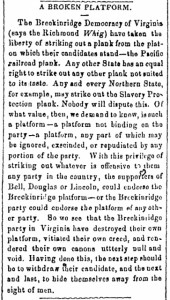 One hundred and fifty years ago today, the Charles Town, Virgina (there wasn’t a West Virginia yet)Free Press commented on reports that the state’s Breckinridge Democrats had abandoned a plank from their “national” party platform by repudiating support for the Pacific Railroad. This one little piece of fewer than 200 words illustrates how complicated the 1860 election was and how challenging it is for students to read nineteenth-century newspapers. The Free Press was a loyal southern rights Democratic paper run by the Gallaher family. They supported John Breckinridge, the nominee of the Southern Democrats and his new party’s attempts to cultivate western support through actions such as endorsing the Pacific (or transcontinental) Railroad and by anointing Senator Joseph Lane from Oregon as the party’s vice-presidential nominee. Yet the article, entitled “A Broken Platform,” reads like harsh criticism of the decision. “So we see,” reads the piece, “that the Breckinridge party in Virginia have destroyed their own platform, vitiated their own creed, and rendered their own canons null and void.” However, a careful reader will note that the piece begins with a parenthetical aside “(says the Richmond Whig)” referring to a leading paper in the state capital that supported John Bell and the Constitutional Union Party. Supporters of Breckinridge and Bell vied fiercely across southern states during the 1860 contest and by quoting from the Richmond Whig the Virginia Free Press was being sarcastic. Nineteenth-century readers understood the nuances (or so we imagine) but the finer differences and unique customs of partisan journalism are very difficult to explain to modern-day students.
One hundred and fifty years ago today, the Charles Town, Virgina (there wasn’t a West Virginia yet)Free Press commented on reports that the state’s Breckinridge Democrats had abandoned a plank from their “national” party platform by repudiating support for the Pacific Railroad. This one little piece of fewer than 200 words illustrates how complicated the 1860 election was and how challenging it is for students to read nineteenth-century newspapers. The Free Press was a loyal southern rights Democratic paper run by the Gallaher family. They supported John Breckinridge, the nominee of the Southern Democrats and his new party’s attempts to cultivate western support through actions such as endorsing the Pacific (or transcontinental) Railroad and by anointing Senator Joseph Lane from Oregon as the party’s vice-presidential nominee. Yet the article, entitled “A Broken Platform,” reads like harsh criticism of the decision. “So we see,” reads the piece, “that the Breckinridge party in Virginia have destroyed their own platform, vitiated their own creed, and rendered their own canons null and void.” However, a careful reader will note that the piece begins with a parenthetical aside “(says the Richmond Whig)” referring to a leading paper in the state capital that supported John Bell and the Constitutional Union Party. Supporters of Breckinridge and Bell vied fiercely across southern states during the 1860 contest and by quoting from the Richmond Whig the Virginia Free Press was being sarcastic. Nineteenth-century readers understood the nuances (or so we imagine) but the finer differences and unique customs of partisan journalism are very difficult to explain to modern-day students.
29
Aug
10
Rupp House – Mechanicsburg, PA
Posted by sailerd Published in Civil War (1861-1865), Places to Visit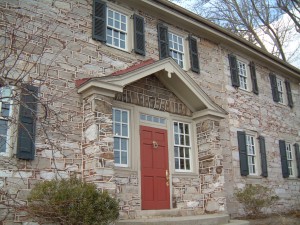 The Rupp House in Mechanicsburg, Pennsylvania served as the headquarters for Confederate General Albert G. Jenkins’ brigade during the Gettysburg campaign in late June 1863. On June 28 Jenkins’ troops captured Mechanicsburg without encountering any resistance. Two days later, however, Jenkins received General Robert E. Lee’s order to regroup at Gettysburg. As Jenkins’ brigade left on June 30, his rearguard became involved in the Battle of Sporting Hill. The Rupp House was built in 1787 by Jonas Rupp. His grandson’s family owned the house in 1863 and they remained in Lancaster, Pennsylvania while the Confederates were in Mechanicsburg. The Rupp House is at 5115 East Trindle Road, but it is currently not open to the public.
The Rupp House in Mechanicsburg, Pennsylvania served as the headquarters for Confederate General Albert G. Jenkins’ brigade during the Gettysburg campaign in late June 1863. On June 28 Jenkins’ troops captured Mechanicsburg without encountering any resistance. Two days later, however, Jenkins received General Robert E. Lee’s order to regroup at Gettysburg. As Jenkins’ brigade left on June 30, his rearguard became involved in the Battle of Sporting Hill. The Rupp House was built in 1787 by Jonas Rupp. His grandson’s family owned the house in 1863 and they remained in Lancaster, Pennsylvania while the Confederates were in Mechanicsburg. The Rupp House is at 5115 East Trindle Road, but it is currently not open to the public.
You can learn more in an essay on ExplorePAhistory.com, Robert Grant Crist’s article “Highwater 1863: The Confederate Approach to Harrisburg” (Pennsylvania History 1963), and in Wilbur Sturtevant Nye’s Here Come The Rebels! (1965).
Image courtesy of Flickr user cthoyes.
24
Aug
10
Refreshment Saloons in Civil War Philadelphia
Posted by mckelveb Published in Civil War (1861-1865), Images, Recent Scholarship Themes: Business & IndustryHouse Divided is in the process of adding interactive essays to the database as a part of its Journal Divided project. I created an essay on the Philadelphia refreshment saloons that specifically focused on the Cooper Shop Volunteer Refreshment Saloon and its contribution to the city’s home front relief efforts during the Civil War. The Cooper Shop opened on May 26, 1861 and went on to add a hospital in October that cared for sick and wounded soldiers throughout the duration of the war. Although larger refreshment saloons formed in the city, Philadelphia’s residents warmly remembered the Cooper Shop because of the dramatic individual efforts of its three leaders: William M. Cooper, the president of the establishment, Dr. Andrew Nebinger, the head surgeon of the Cooper Shop Hospital, and Anna M. Ross, the Lady Principle of the hospital. Visiting physicians such as Dr. C.E. Hill described the positive atmosphere created by the committee’s hospitality and claimed, “soldiers were never better cared for than in this hall.” The refreshment saloons are still remembered in modern scholarship as historian J. Matthew Gallman commented, the saloons “greatest benevolent contribution cannot be measured by returns on ledger sheets, but by the long hours devoted to sewing clothes, cooking food, and ministering to wounded soldiers.” The saloons closed in late August 1865 as the war came to an end and they were no longer needed.
For more interactive essays, visit the Journal Divided Site. Click on any of the images below to view a slide show of the Philadelphia Volunteer Refreshment Saloons during the Civil War in Flickr.
